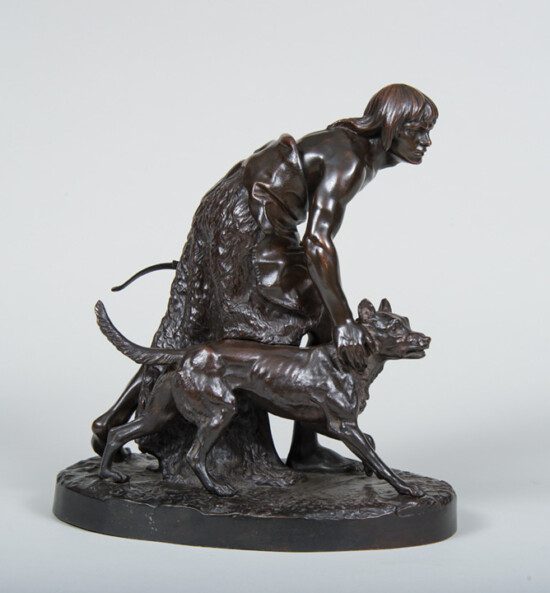AUCTION 2023 (APRIL),
LOT 290
Additional Information
The Indian Hunter was one of the standout pieces in the Metropolitan Museum of Art’s influential 2013 exhibition The American West in Bronze, 1850-1925. New Yorkers were already familiar with the piece—a monument of the hunter and his dog has been in Central Park since 1869—but many were first introduced to the work of John Quincy Adams Ward during the exhibition. The piece, created in 1860, is one of 15 known casts of the sculpture. Other casts are in collections at the Met and the Denver Art Museum.
“Although the sculpture recalls sources from the antique—notably the Louvre’s marble Borghese Gladiator (3rd-1st century B.C.), a reduced plaster cast of which Ward had in his studio—to contemporary viewers, the face of Ward’s hunter was ‘subdued to no fancied requirement of the classic ideal.’ The critic for the New York Times called the hunter a ‘wild varmint of the wood…himself an animal fierce and instinctive as the dog by his side.’ The statuette’s extraordinary surface treatment in the trailing fur robe and the dog’s curly ruff visually links man and beast,” writes Carol Clark in the exhibition’s catalog. Clark also notes that early praise for the work is what eventually led to the monument in Central Park.
Once the decision was made for the monument, Ward got to work on a plaster cast, which was on display in a Broadway store until enough patrons could be found to have it cast in bronze. When it finally did get placed near present-day 65th Street, it was the first work by an American sculptor to be installed in Central Park. “John Quincy Adams Ward’s Indian Hunter established him as a sculpture of American subjects whose combination of realism and vigorous outdoors masculinity in bronze stood in opposition to the marble female nudes of his peers in Italy, who worked in a neoclassical style Ward feared drew ‘a sculptor’s manhood out of him,’” wrote Karen O. Janovy in 2005. “Indeed, The Indian Hunter helped Ward’s reputation survive the changes introduced to sculpture after the Civil War by French naturalism. As Augustus Saint-Gaudens, the American leader of that school said, ‘His work and career, his virility and sincerity, have been a great incentive to me, from the day when he exhibited his Indian Hunter in an art store on the east side of Broadway.”
CONTACT US
Email: info@scottsdaleartauction.com
Phone: (480) 945-0225
DISCLAIMER
Please note that the first unframed photo is most accurate for color. Framed photographs are to show the frame and are not color corrected to the painting.
*The Condition Reports are for guidance only and should not be relied upon as statements of fact, and do not constitute a representation, warranty, or assumption of liability by Scottsdale Art Auction. Scottsdale Art Auction strongly encourages in-person inspection of items by the bidder. All lots offered are sold “AS IS”. Please refer to item two in our terms and conditions for further information.

